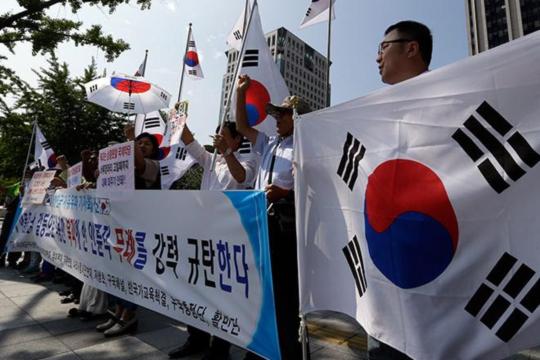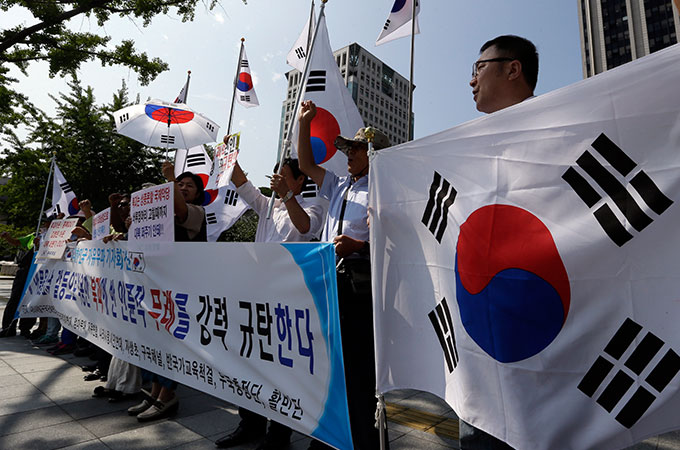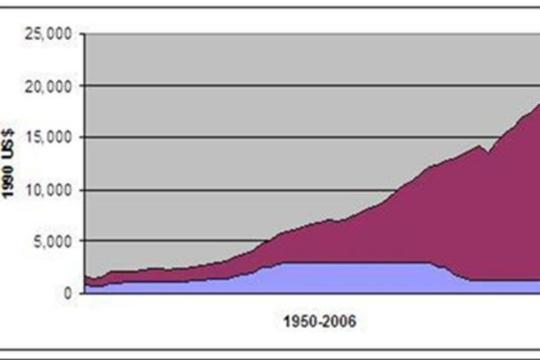
 |
| South Korean protesters shout slogans as they hold national flags during a press conference against abrupt cancellation by North Korea of planned reunions for families separated by the Korean War in front of the government complex in Seoul [AP] |
Abstract
The Korean division is now approaching its eighth decade. The Republic of Korea (RoK, or South Korea, SK) and the Democratic People’s Republic of Korea (DPRK, or North Korea, NK) remain locked in a surprisingly persistent cold war struggle. Although most observers (1) would conclude that North Korea has ‘lost’ the competition by almost any metric – most obviously, economic performance – the DPRK soldiers on. Relations between the two are poor, erratic, and prone to crisis. The demilitarized zone dividing them remains, ironically, the most militarized place on earth with roughly two million soldiers and tens of thousands of tanks, rockets, and artillery within 75 miles on either side.
This brief will summarize NK’s survival efforts and antagonism of SK since the conclusion of the Cold War, the decisive turning point against the North in the inter-Korean competition. Broadly I will argue that inter-Korean relations could improve – the ideological divisions are mostly moot with the passing of communism and North Korea desperately needs external assistance. However the Kim dynasty of Pyongyang, the family leadership caste, has a vested interest in avoiding reconciliation; it would throw their brutal behavior into high relief and raise the possibility of unification which likely mean the absorption of NK. China, NK’s patron, also has little interest in reconciliation. Hence the stalemate and cycle of provocation continues.
The End of Cold War and North Korea’s Permanent Legitimacy Crisis
The Cold War divided several nations into competing states – Korea, Germany, Vietnam, China, Yemen. In each case, a broad sense of underlying national-cultural unity was maintained in the face of an ‘artificial’ political separation. Unification was to take place at some point in the future. The unstated assumption was that one political model would ‘out-race’ the other, highlighting the other’s obsolescence and triggering unification. This roughly occurred in Germany and Vietnam. By the end of their internal competitions, it was increasingly clear that the ‘loser’ had no popular legitimacy and no further raison d’etre as a separate national state. This too is the case in Korea. It is the root of the widespread expectation that NK will one day collapse and that the RoK will extend its jurisdiction over the entire peninsula. Conversely, no one plausibly believes that Northern-led unification is a possibility any longer. Even NK itself admits that South Korea has outperformed it economically. (2) The Korean race is all but over. So Pyongyang’s primary interest today is to forestall unification - to protect the NK elite deeply implicated in human rights abuses and corruption - despite pro-forma declarations that it still seeks unity.
The cause is South Korea’s tremendous economic performance. With just fifty million people, it is today the world’s thirteenth largest economy and member of the G-20. It overcame crushing, third-world levels of poverty in the 1950s. For a brief period, until the late 1960s, NK did outgrow SK, and Northern-led unification seemed possible after the US defeat in Vietnam. NK’s long-serving first leader, Kim Il-Sung, even asked at the Soviet Union and China at the time for support for a second unification war. But all such talk faded by the 1980s. NK had begun to stagnate as its Soviet sponsor was doing. SK began to seriously pull-away (Table 1), questioning for the first time the legitimacy of NK’s very existence. NK’s existence as a communist state was premised ideologically on its ability to deliver better, or at least, fairer, economic growth than SK. By the 1980s this was clearly untrue, and the North Korean population increasingly knew that too. So desperate was NK to block the 1988 Seoul Olympics, which would demonstrate this Southern superiority to the world, that it blew up a SK airliner (KAL 858) in 1987.
 |
| Table 1: North (blue) and South (purple) GDP per capita |
The disappearance of the Soviet Union worsened the economic stagnation; NK turned to be far more dependent on Soviet credit and concessionary fuel than outsiders realized. The crisis of the 1990s worsened with the death of Kim Il-Sung in 1994 and transfer of leadership to his untested son, Kim Jong-Il. Jong-Il, fearful of his position, elevated the (North) Korean People’s Army (KPA) to a unique role (the ‘military first’ policy). The KPA has since systematically stripped resources from the civilian economy and the onset of a series of bad harvests in turn generated an unprecedented famine. Estimates range as high as three million deaths, which would exceed 10% of the population. (3)
The combined impact of these overlapping crises and SK’s clear economic superiority was to throw NK into a permanent legitimacy crisis. Why did NK even exist anymore, when a wealthy, healthy, prosperous Korean alternative existed right next door? The long-standing ideological reason for NK’s existence – the Cold War - was now gone; Germany, Korea’s most obvious parallel of cold war division, was unified. Like East Germany, NK was poorer, less educated, growing more slowly, corrupt, badly administered, and Orwellian. (4) East Germany’s demise was welcomed, as would be NK’s. Predictions were common in the 1990s that NK would implode soon. (5) In South Korea, a policy of détente – the Sunshine Policy – was adopted in the late 1990s to coax (seemingly) collapsing NK into the global post-cold war system. As the post-cold war era matured, NK was increasingly seen as a dangerous, bizarre anachronism, forcing Pyongyang into ever more complex contortions to justify its own continuing existence.
The Nuclear Program and the Emergence of the Kim Monarchy
The NK response to its dramatic reversal of fortune in the 1990s was accelerate its nuclear program and increasingly turn regime ideology from Marxism to racist nationalism and a theocratic cultism of the Kim family. (6)
Despite the formal DPRK commitment to unification with the South, the regime likely does not want unity. NK is likely the world’s worst human rights abuser. (7) As such it is likely that Korean unification would lead to widespread calls for the prosecution of the Pyongyang elite. That interwoven clique of top KPA brass, high officials in the communist party (the Korean Workers’ Party), and loyalists of the Kim family are all broadly complicit in the network of gulags, torture, and orwellian surveillance and indoctrination for which NK is notorious. Unification scenarios inevitably require the loosening of the NK police state in exchange for Southern assistance. It is simply impossible to imagine SK, an established democracy, becoming more authoritarian to accommodate Pyongyang, and NK needs Southern assistance, not vice versa. As a result any meaningful federation would impact one-party rule in the North, eventually exposing the murderous Pyongyang old boys network to outside scrutiny that would heighten pressure for serious political change. Further, SK retains the death-penalty, likely to consider in post-unification trials. In short, the risks to the Kim elite of unity are enormous, including facing the hangman’s noose in united Korea, but they are ideological trapped into pro-forma support for unity.
NK must therefore continually manufacture crises by which to justify its increasingly inexplicable existence, and it must re-invent itself ideologically now that communism is passé. This is the purpose behind events such as the Cheonan sinking or the Yeongpyoeng shelling in 2010. (8) This is also the thrust behind the strongly anti-American ideology of the regime. (9) Without tension with its neighbors, NK cannot explain to its own people why they are so much poorer than their Southern cousins. (North Koreans know much more about South Korea than ever before, because North Koreans built substantial informal networks with Chinese during the famine. Those trading networks across the border brought in food during what NK calls the ‘Arduous March,’ and they persisted afterward. Today they bring in DVDs, flashkeys, and cell-phones that have given North Koreans unprecedented access to outside information.)
The evolution of Northern ideology into the semi-deification of the Kim family – the current third Kim, Jong-Un, is the son of Jong-Il – serves a similar purpose of distinguishing North from South Korea. If the Kim monarchy carries a unique right to rule, cloaked in Korean Chosun myth and legend, then South Korea looks like a shallow, illegitimate American import (the ‘Yankee Colony’) by comparison. And indeed, the first thing foreign visitors must do in Pyongyang when they visit is bow to gigantic statues of Kim Il-Sung and Kim Jong-Il on Mansudae hill. (I visited NK in 2012, and this submission is required of all visitors without exception.)
Finally, the nuclear program serves to both justify North Korea’s post-communist existence and to deter SK and American intervention. Pyongyang routinely asserts that the United States pursues a ‘hostile policy’ toward it. (10) And indeed the US has wavered for decades on whether to pursue normalization – including recognition of NK and acceptance of its right to exist – or regime change. George W. Bush, most famously, demanded regime change in placing NK on its ‘axis of evil.’ SK too goes back and forth on whether to strike a long-term deal with NK for peaceful coexistence, or to push for the final collapse of NK and ultimate unification. The previous president of SK was a strong hawk, while the current one sends mixed signals of accommodation. (11)
Nuclear weapons are therefore a powerful deterrent. They make the costs of US-SK regime change unbearable. A Northern nuclear strike on the Southern capital, Seoul, would be catastrophic, so Northern security is dramatically enhanced. Nukes also enhance the prestige of the state. NK, a small, poor, half-country, nonetheless built these elite weapons which allows the DPRK to stand tall against the South, the Americans, Japanese, and Chinese. Hence, Kim Jong-Un called the North’s nuclear program the ‘life of the nation. (12)’
The Chinese Patron
A final element in the prevention of unification is Chinese support. The retraction of Soviet support in the early 1990s hit NK hard, accelerating the slide into the late 90s famine. Under liberal presidents in SK from 1998-2008, SK assistance helped prop-up the regime. But this ‘Sunshine Policy’ raised significant expectations in the South that NK would change in response to this assistance. But changing the DPRK too much threatens the very existence of NK, and more importantly the Pyongyang elite that benefits from the current arrangement. If NK becomes just another state, akin to an emerging economy with an IMF program and so on, rather than a unique Korean nationalist monarchy, then there is no reason for it to continue to be. In the end, ‘Sunshine’ failed, because NK cannot change too much or it will accelerate its own demise. By 2007, South Korean voters saw this and elected a conservative, as they did again in 2012.
This is has pushed NK into the arms of the Chinese. The US and Japan both offered aid in exchange for change at various time in the last twenty-five years, but NK cheated too often on such deals for them to return. This leaves only China, which has gained increasing leverage over NK. (13) While this is better than US, SK, or Japanese aid with serious political conditions attached, it is still not ideal. There is a fairly wide consensus in Korean studies that if China pulls the plug, NK will undergo a severe systemic crisis. Indeed, my own thinking is that NK could not in fact survive a Chinese withdrawal.
Luckily, China values NK as a buffer. (14) Beijing fears a larger, wealthier, democratic, nationalist united Korea. It also fears that a unified Korea would remain a US ally, as unified Germany has done. This could then lead to the stationing of US forces near the Chinese border, and this was, of course, the issue that provoked Chinese intervention in the Korean war in 1950. Until China changes its threat evaluation of the US – which is actually worsening due to the US ‘pivot’ to Asia which the Chinese read as containment (15) - NK is relatively secure. Nonetheless, the Northern nuclear program also helpfully serves to prevent Chinese political domination even as the alliance leads to a subtle Chinese take-over of the Northern economy.
Conclusion: the Future of North Korea
This tangle of competing external interests creates the stalemate which has fallen on Korea since the end of the Cold War. (16) The loss of Soviet support and famine created the greatest crisis in the DRPK’s history. But NK has wisely played its neighbors against each other for aid. When the Sunshine Policy dried up, NK re-discovered it ‘historic’ relationship with China (as close as ‘lips to teeth’). The great threat then is, can NK survive if China too withdraws assistance? Luckily for the Kim family, this seems unlikely in the medium-term.
There is little SK can do in such an environment. NK was unresponsive to Southern aid under the Sunshine Policy, and it lashed out under the previous hawkish president. Today, the Southern attitude is cautious engagement – essentially buying NK off from its most provocative behavior while trying avoid the outright subsidization of the Sunshine Policy. (17)
This feels unsatisfactory all round. It leaves Korea semi-permanently divided and abandons the North Koreans to the whims of a tyranny ‘worse than 1984.(18)’ But Chinese support, nuclear weapons, and an aggressive nationalist/quasi-theocratic ideology has buttressed NK through the post-Cold War period better than anyone thought possible. Only a major Chinese turn against NK could seriously jeopardize this remarkably persistent structure.
____________________________________________________
*Robert E. Kelly is an associate professor of international relations in the Department of Political Science and Diplomacy at Pusan National University.
Endnotes
(1) Kyung-Ae Park and Scott Snyder, eds. (2012) North Korea in Transition: Politics, Economy, and Society (New York: Rowman and Littlefield).
(2) B.R. Meiers (2011) The Cleanest Race: How North Koreans See Themselves and Why It Matters (New York: Melville).
(3) Andrew Natsios (2002) The Great North Korean Famine (Washington, D.C.: United States Institute of Peace).
(4) A reference to George Orwell's 1984. NK is the most totalitarian system ever created - more stalinist than even the USSR under Stalin.
(5) Meiers, Cleanest Race; Robert Kelly (2012) “North Korea is Kim-Land,” JoongAng Daily, October 18: http://koreajoongangdaily.joins.com/news/article/article.aspx?aid=2960958; Eun Hee Shin (2006) “The Sociopolitical Organism: The Religious Dimensions of Juche Philosophy,” in Robert Buswell (ed.) Religions of Korea in Practice (Princeton: Princeton UP).
(6) Begin at the Human Rights Watch page on NK: http://www.hrw.org/nkorea.
(7) Robert Kelly (2010) “How to Respond if North Korea really Sank that SK Destroyer: ‘Sell’ Southern Strategic Restraint to China for Pressure on the North,” Asian Security Blog, April 22: http://asiansecurityblog.wordpress.com/2010/04/22/how-to-respond-if-north-korea-really-sank-that-sk-destroyer-sell-southern-strategic-restraint-to-china-for-pressure-on-the-north/.
(8) Robert Kelly (2010) “Yeonpyeong Shelling Summation (1): Context and Causes in Hindsight,” Asian Security Blog, December 13: http://asiansecurityblog.wordpress.com/2010/12/13/yeonpyeong-shelling-summation-1-context-and-causes-in-hindsight/.
(9) Patrick McEachern (2010), Inside the Red Box: North Korea's Post-Totalitarian Politics (New York: Columbia University Press).
(10) Korea Times (2013) “NK says will retain nukes until US ends Hostile Policy,” October 18: http://www.koreatimes.co.kr/www/news/nation/2013/07/113_122614.html.a
(11) Robert Kelly (2012) “Strategic Patience?” Newsweek Korea, July 8 (issue 1084): English translation available at: http://asiansecurityblog.wordpress.com/2013/07/04/my-newsweek-korea-cover-story-a-defense-of-obamas-strategic-patience-on-north-korea/.
(12) CBC News (2013) “North Korea calls nuclear weapons 'nation's life,'” March 31: http://www.cbc.ca/news/world/north-korea-calls-nuclear-weapons-nation-s-life-1.1303455?cmp=rss.
(13) Victor Cha (2011) “China’s Newest Province,” New York Times, December 11: http://www.nytimes.com/2011/12/20/opinion/will-north-korea-become-chinas-newest-province.html?_r=0.
(14) Jayshree Bajoria and Beina Xu (2013), “The China-North Korea Relationship,” Council on Foreign Relations February 21: http://www.cfr.org/china/china-north-korea-relationship/p11097.
(15) Robert Kelly (2013) “Why the West Should Relax about China,” Diplomat, September 6: http://thediplomat.com/2013/09/06/why-the-west-should-relax-about-china/.
(16) Robert Kelly (2013), “North Korea is the Boy who Cried Wolf: There will be No War,” Diplomat, April 13: http://thediplomat.com/2013/04/10/north-korea-is-the-boy-who-cried-wolf-there-will-be-no-war/.
(17) Robert Kelly (2013) “Don’t Sweat the Closure of Kaesong,” Diplomat, May 12: http://thediplomat.com/2013/05/12/dont-sweat-the-closure-of-the-kaesong/.
(18) Christopher Hitchens (2005) “Worse than 1984,” Slate May 2: http://www.slate.com/articles/news_and_politics/fighting_words/2005/05/worse_than_1984.html.